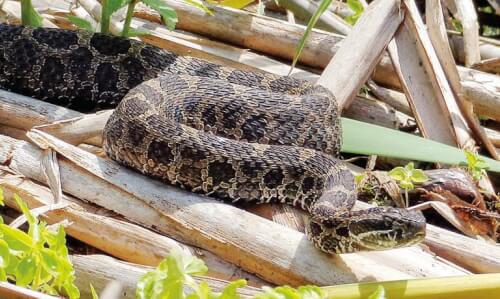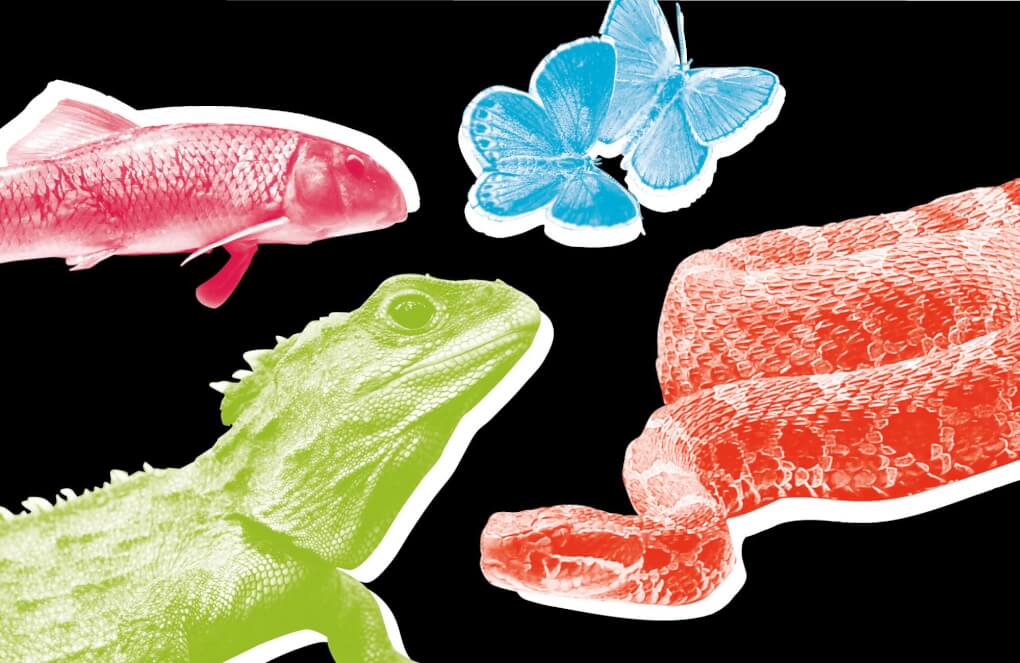More than 26,000 species around the world are considered threatened and more than 1,400 species of animals are listed as endangered or threatened in the U.S. alone, according to the U.S. Fish & Wildlife Service.
From New Zealand to Grand Rapids and from snakes to butterflies, Grand Valley professors and students have conducted research in an attempt to either remove certain species from these lists or help prevent threatened species from being added. They are studying the eastern massasauga rattlesnake, tuatara, Karner blue butterfly and river redhorse.

EASTERN MASSASAUGA RATTLESNAKE
The eastern massasauga rattlesnake slithered its way onto the U.S. Endangered Species List in September 2016 primarily due to habitat loss resulting from land conversion to agriculture.
Jennifer Moore, professor of biology, and a team of rotating students have been conducting ongoing research in an effort to save the species.
The largest remaining populations of eastern massasauga reside in Michigan and can typically be found in small populations in wetland habitats in the Lower Peninsula.
Since 2013, Moore and her students have attempted to better understand the ecology of these snakes by studying populations at four sites. One of those sites, Bois Blanc Island, is currently a control site because Moore said there are “rattlesnakes all over the island and the landscape is relatively unmodified.”
Aside from field research, the team has worked with staff at Pierce Cedar Creek Institute, in Barry County, to assess the long-term viability of the species.
Nathan Kudla, a graduate student majoring in biology, began working with Moore as an undergraduate student as a student researcher at the institute. Now a graduate student, Kudla is conducting a landscape genetics study.
“We are trying to better understand how the landscape influences their movement and population structure and how human habitat modifications impact the species,” Kudla explained.
Moore received two grants after the species was listed, from the U.S. Geological Survey and the U.S. Fish and Wildlife Service. Through the grants, her team was able to begin assessing how many populations persist in Michigan.
“The goal was to get out and re-survey some of those sites where we know we have historical records of them residing, but that no one has checked in the last 20 years,” said Moore.

“The goal was to get out and re-survey some of those sites where we know we have historical records of them residing, but that no one has checked in the last 20 years,” said Moore.
Arin Thacker, a second-year graduate student, has been leading the occupancy reassessment.
“What I enjoy most about my work is having the opportunity to work closely with a species that is generally not well understood,” said Thacker. “I feel this research is important because it will ultimately guide scientists and natural resources managers to both sustain and restore habitats in which massasaugas are found.”
The grants also funded research around population connectivity, meaning how easily and frequently groups of eastern massasaugas are able to interact with one another.
Moore said there are major concerns that arise when populations are unable to engage.
“These populations tend to be super small and isolated, so that’s bad for those populations over time because it tends to lead to things like inbreeding,” she said.

Tuatara
TUATARA
Moore recently spent nine weeks of a sabbatical conducting new research and experiments that may help keep tuatara off the endangered species list.
She said fossil records indicate close relatives of the tuatara used to be scattered across the globe, but now can only be found on the islands of New Zealand. The tuatara may look like a lizard, but the species actually makes up its own order within the four taxonomic orders of reptiles. The other three include snakes and lizards, alligators and crocodiles, and turtles and tortoises.
Moore first encountered tuatara during her doctoral program at Victoria University of Wellington in New Zealand about 10 years ago. Her focus then was the same as it was during her recent sabbatical: understanding reproductive ecology to improve conservation and captive breeding.
She said that many institutions, namely zoos, would like to add tuatara, but they are too few in number. Only four zoos in the U.S. and one in the United Kingdom have tuatara.
“It’s very challenging to get any animals out of New Zealand, so this may improve captive breeding efforts in the future,” she said.
Moore’s field research took place on Stephens Island/Takapourewa, where about half of the world’s tuatara live.
“Stephens Island has been a really important location for past translocation efforts,” said Moore. “We want to attempt to understand male reproduction, which has been a black hole of knowledge up until now.”

Moore, along with Nicola Nelson, deputy head of Victoria University’s School of Biological Sciences, and Helen Taylor, postdoctoral researcher at the University of Otage, collected sperm samples in the field from male tuatara, which has never been done before.
“Helen has this cool machine that collects information on sperm quality in the wild and analyzes it right on the spot,” said Moore. “The reproductive anatomy of a tuatara is very different from that of other reptiles and birds, so it’s kind of uncharted territory.”
The goal of this research is to develop a system of artificial insemination that will increase captive breeding potential.
“The idea is that instead of shipping animals around, which is nearly impossible for many reasons, we may be able to collect sperm and ship that around to different islands or institutions, but that’s way down the road,” said Moore.
While in New Zealand, Moore collaborated with staff at Wellington Zoo, which she said is the global hub of captive management databases and records on tuatara.
She said the isolated populations of tuatara is one of her main attractions to this species and research.
“Stephens Island is this magical place and here are these animals that are of huge conservation concern and wild populations are only found on these tiny offshore islands,” said Moore. “We fly to the island via helicopter and once you land, they are everywhere. It feels like you’re in Jurassic Park.”


KARNER BLUE BUTTERFLY
James Dunn, professor of biology, has been studying the Karner blue butterfly for the past 16 years. This species was officially listed on the federal endangered species list in 1992 after dramatic population declines due to habitat loss and modifications.
“They were originally found in Wisconsin and as far east as New Hampshire, but now there are only isolated populations in Wisconsin, Michigan and New York,” said Dunn.
His first task was locating sites in Michigan where Karner blues could be found; he found large populations in the Manistee National Forest and the Allegan State Game Area.
“Once I found those, I wanted to primarily study their ability to disperse among different locations,” said Dunn. “Dispersal is a very important part of sustaining populations because isolated patches of butterflies that can’t disperse from one location to another often leads to local extinctions.”
Dunn enlisted more than a dozen Grand Valley undergraduate students to help him study the dispersal capabilities of Karner blues.
The team performed mark, release, recapture studies at 20 different sites within a two-kilometer area in Manistee National Forest between 2005-2006. The goal was to determine if Karner blues could fly between sites or if they had to use what are known as “wildlife corridors,” or the equivalent of a rest stop between sites.

“We found, contrary to what was previously written, they actually disperse as far as 2,000 meters, not only about 150-200 meters,” said Dunn. “And they can do 2,000 meters in one day.”
Yumiko Jakobcic, director of Grand Valley’s Office of Sustainability Practices, aided Dunn as an undergraduate student. Dunn said she had a very particular skill that proved invaluable.
“When you catch a butterfly, you mark a unique number with a fine-tipped sharpie on the underside of its wings, so, honestly, if it weren’t for Yumiko’s beautiful penmanship and sleight of hand, I don’t know if we would’ve completed that study,” said Dunn.
Jakobcic said she fell in love with this particular species of butterfly during the project.
“It felt like a privilege to have the opportunity to help a species that truly needed this research,” said Jakobcic. “I still use some of the lessons I learned on this project and I feel so lucky that I was able to experience that type of work as an undergraduate student."
Dunn and two graduate students will move their research forward this year with two new studies this summer. One will examine the feeding behaviors of adult Karner blues and another will study the plant and pollinator community in Michigan, which Dunn said is extremely important for the flowers that support Karner blues.

RIVER REDHORSE
As an undergraduate student, Nicholas Preville focused various research projects on broad ecological issues, such as dam removal, culvert replacement and dredging projects in cold-water rivers.
Now a graduate student majoring in biology, he is focusing on better understanding the river redhorse, a species of fish that is listed as “state-threatened” in Michigan. He chose this species with the guidance of Eric Snyder, professor of biology and biology graduate program coordinator, as well as through conversations with staff at the Michigan Department of Natural Resources and Michigan Sea Grant.
Preville said he’s attracted to the river redhorse because it has been understudied.
“We know almost as little as you can about a species in our own waters,” said Preville. “We know where they spawn and some of their physical attributes, for example, they have pharyngeal teeth in their throats that are used to crush mussels and clams. The species has also been documented as potential biological control agents for zebra mussels and Asian clams.”
Native to Michigan, this species of fish can be found in the Grand, Muskegon and St. Joseph rivers. The river redhorse is also imperiled in 13 states and provinces.
Preville’s research has consisted of experiments to help understand where river redhorse spawn in the Grand River Watershed and its habitats.
He worked with the Michigan Sea Grant to tag 15 river redhorse, which required learning how to operate on a fish using the “shielded needle” technique.

“After anesthetizing the fish, you create an incision in their body cavity, insert a hollow metal tube into the incision and then a large needle into the tube,” Preville explained. “The tracker also includes a trailing antenna that hangs outside of the fish, so after you sew them up and let them recover, you can easily track them through the water.”
Preville also used an Environmental DNA analysis to take water samples from tributaries where he thought river redhorse might be spawning and then attempted to synthesize DNA out of those samples to see if they were present in those systems.
“Unfortunately, synthesizing DNA from water samples proved to be difficult because there are a lot of little plant constituents that can mess with the amplification process,” said Preville.
Fortunately, the technique Preville developed can still be used as a genetic ID tool to differentiate between river redhorse and other redhorse species.
The next steps for the research include learning more about river redhorse patterns in the fall and winter and taking a closer look at Michigan’s mussel population, which is a primary food source.
Preville said the two greatest threats to the river redhorse are water control efforts, such as dam construction, and pollution. He is also attempting to use his research to encourage policymakers and citizens to consider a “holistic river management” solution.
“Rather than trying to manage for a single species, we should be trying to keep the river systems as a whole as healthy as we can,” said Preville. “I think people need to start taking a more positive look at the services a natural ecosystem provides instead of just plundering it for its resources.”







